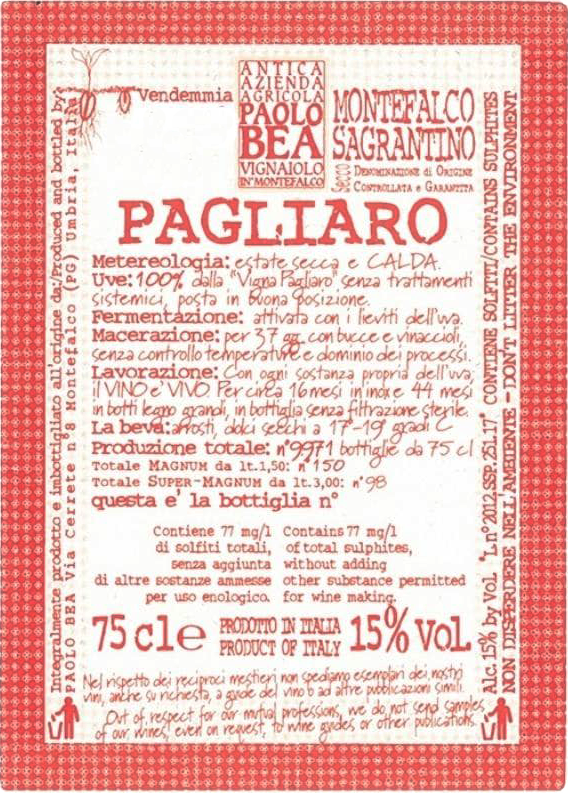
Paolo Bea
Wines
Montefalco
“Santa Chiara”, Umbria Bianco
A white wine produced from Grechetto, Malvasia, Chardonnay, Sauvignon and Garganega, in approximately equal proportions, planted in the Pagliaro vineyard, a site with alternating layers of gravel and clay at 1,300 feet above sea level with both east and southwest facing parcels. After crushing, the juice spends at least two weeks macerating on its lees; sulfur is never added. Fermentation occurs in small stainless steel vats at low temperatures. Two rackings are done early in the fermentation process to remove the heavy deposits and a third is done after three weeks. This wine is then left on the fine lees in stainless steel for one year before being bottled. Approximately 4,500 bottles of wine are produced annually.
“Arboreus”, Trebbiano Spoletino, Umbria Bianco
“Arboreus” is made from a Trebbiano clone known as Trebbiano Spoletino which is trained so that the fruit hangs high above the ground. The vineyards are planted in the low hills between Trevi and Montefalco at an elevation of 650 to 700 feet with a range of parcels facing both to the east and to the southwest. The soil is essentially clay and gravel. Harvest generally occurs during the first two weeks of October. The wine is left in contact with the skins for up to three weeks or more and is then aged in stainless steel tanks for at least two years prior to bottling. Sulfur is never added. Annual production is in the range of 3000 bottles.
“San Valentino”, Umbria Rosso
This wine is sourced from the San Valentino vineyard in Montefalco the soil of which is dominated by clay. The vineyard is at 1300 feet altitude. The composition of the Montefalco Rosso is 70% Sangiovese, 15% Sagrantino and 15% Montepulciano, all from a 50-year old vineyard containing the constituent grapes. Harvest usually occurs in the final ten days of October. Bea puts all the dry reds through extensive cuvaison. In this instance, the wine usually macerates for approximately 30 days before being racked and prepared for the malolactic fermentation. The wine is aged for 3 years in stainless steel and an additional 4 to 12 months in bottle before release.
Montefalco Rosso Riserva, “Pipparello”
The Pipparello vineyard is a hilltop site in Montefalco at 1300 feet above sea level. The soil is clay and gravel. The vines in the vineyard are a minimum of 20 years old. Harvest takes place normally during the middle of October. The ultimate wine is a blend of roughly 60% Sangiovese, 25% Montepulciano and 15% Sagrantino. The cuvaison extends for a period between 40 to 50 days. After the alcoholic fermentation this wine spends a year in stainless steel tanks and then two years in large oak barrels and is released after an additional year of bottle-aging.
“Rosso de Véo”, Umbria Rosso
“Rosso de Véo” is a selection of the Bea estate’s younger Sagrantino vines, principally from the Cerrete vineyard which graces the highest point in Montefalco, between 1300 and 1500 feet above sea level. The soil is clay and limestone infused with small pebbles from an ancient riverbed. This wine is vinified in a similar fashion to the single vineyard Sagrantino with a long cuvaison which extends forty to fifty days. The wine is then aged one year in stainless steel tanks, two years in large oak barrels and another year in bottle before release. The wine is not filtered. Production varies depending on vintage … 9000 bottles were produced in 2005, the first year this exclusively Sagrantino-based cuvée was created.
Montefalco Sagrantino Secco, “Pagliaro”
The fabled local grape of Montefalco is the Sagrantino and the Pagliaro vineyard, situated at 1,300 feet in altitude, is dedicated in large part to this grape variety. The harvest of Sagrantino normally occurs during the second half of October. The cuvaison extends for forty to fifty days. The wines is then aged for one year in stainless steel, another two years in large Slavonian oak barrels and, finally, spends one more year in bottle (the wine, like all Bea wines, is unfiltered) before release. Annual production from the Pagliaro vineyard is 15,000 to 20,000 bottles.
Montefalco Sagrantino Secco, “Cerrete”
The cooler and drier position of the Cerrete vineyard, located at the highest altitude in Montefalco, take Sagrantino to new heights. Fermentation begins naturally after a 45-day maceration, then the wine spends a year in steel tanks, before resting for 43 months in large oak barrels. The resulting wine is intense in nearly every aspect, with a deep violet color, robust tannins, and power that announces itself from the first aromas through the persistent finish. Despite all of this intensity, the wine is not heavy, as the terroir provides lift and elegance that enchants the senses.
Montefalco Sagrantino Passito
This rare and very special wine, made exclusively from Sagrantino, is harvested late and left to raisin for four months before pressing. As it air dries, a white mold forms that balances and concentrates the acid, sugar and tannins. The grapes, as raisins, contain approximately 30% sugar at this point (January of the following year) and they are then de-stemmed and crushed. Fermentation begins and slowly progresses until the sugar level reaches 16% to 18%; pressing then takes place and the resulting wine carries approximately 90 grams of residual sugar. The wine is then aged in stainless steel for four years or more and then an extra in bottle. It is not produced every year and, when it is, 1,000 to 2,000 half bottles are produced.









